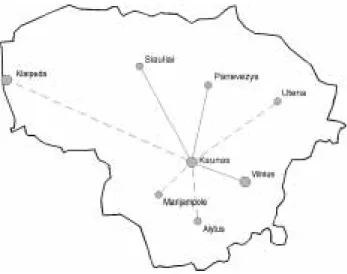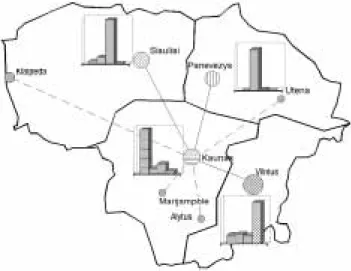Admission to Lithuanian Universities:
Evolutional Development of the Consolidate Information System
Kestutis Pocius and Giedrius Deveikis
Kaunas University of Technology
Darius Braukyla
Vilnius Gediminas Technical University
Marijus Jurgutis
Vilnius University Kestas.Pocius@pit.ktu.lt Darius.Braukyla@adm.vtu.lt Marijus.Jurgutis@sc.vu.lt devegied@pit.ktu.lt
Studentu str. 50-402, LT-3028 Kaunas, Lithuania
Keywords: Admission , University , Internet , Technology
Abstract :This presentation describes the admission to Lithuanian uni- versities and reflects the main changes in related processes covering the last three years (1999-2001). Founded in 2000, Lithuanian Universities' Council on Admissions (LUCA) started managing all common efforts in the development of the consolidate Information System for the admission.
Our system is absolutely based on internet technologies usage and active participation of every university.
Preface
The preparation of Lithuanian Law on Higher Education (HE) started only after the restoration of Lithuania's independence (1990-1991).
Until now the Law was rather concise and schematic leaving the Government to regulate most of the practical issues related to the organization of studies and functioning of higher education institu- tions. On the other hand, after providing that ªinstitutions of higher education are to be granted autonomyª such institutions interpret the concept of autonomy rather broadly.
According to the EU PHARE HERIL (HE Reform in Lithuania) pro- gramme (1998-1999) and its subprogramme ª Lithuanian higher edu- cation and research information system (LieMSIS)ª [1], two
important issues were initiated and developed: ªLithuanian Law on Research and HE ª (already in power from the middle of the year 2000) and LieMSIS specification (several IT projects will start in this year 2001) [2]. Now again, the matter of the autonomy should be reflected in the new statutes of HE institutions according to the new Law. Thus in the nearest future we expect major organizational, structural, and functional changes in the field of HE.
The autonomy of HE institutions also strongly influenced the ad- mission processes and order: each single state institution developed its own admission requirements and criteria: from the attraction of pupils when HE wasn't popular (1990-1995) until the implementa- tion of sophisticated entrance exam system afterwards.
On the other hand there are many changes in general education schools and secondary education system. In this system there started
to funcion a new National Exam Centre (NEC). Unfortunately at the moment it only dublicates the finals of secondary schools while pro- viding pupils to choose whether to pass exams at school or at NEC.
Meanwhile HE institutions tolerate choice of pupils but at the same time run their privious policy as entrance exams.
Problem overview
Until 1999, having the pure Legal Bases and State Regulation of HE system every Lithuanian HE institution was fully involved into its an- nual admission process more or less closely connected to its own In- formation System (IS). Several IT means and instruments are in usage to support the admission processes and provide the Ministry with documents for consideration and reporting accordingly. Though the common admission system is a case of the concept of the LieMSIS project, some of HE institutions started to promote this initiative be- fore now.
Against all the odds two major Lithuanian universities, Kaunas Uni- versity of Technology and Vilnius University, were novice introducing the unified application form for secondary school applicants and creating the IS for the Common Admission.
Founded in 2000 Lithuanian Universities' Council on Admissions (LUCA) started managing all common efforts in the development of a consolidate IS for the admission. At the same time there was orga- nized the Executive Committee as well as established a Team of IT professionals. All organizational structures were founded on the base of universities' representatives working on admission issues.
The i) Common Data Set on admission, ii) admittance regulations, and iii) admission procedures are a collaborative effort of LUCA's membership. Under the supervision of Ministry, this public order takes effective power and is published annually [3]. Already by tradi- tion, admittance regulations are split into general and institutional parts. When a university joins LUCA, it begins a collaborative work in the development of the infrastructure to support its local admis- sion office and pupils who learn about new IT usage, digital signature, private data protection, and other key aspects necessary for them to function in the open IS effectively.
42 Management of Universities
LUCA aims at improving the quality and accuracy of information provided to all involved in pupils' transition into higher education, as well as assisting universities in compiling and reporting information.
Initially having ten associated members LUCA is intended to grow in the nearest future (there are 7 active members now, 15 Universities and 7 Colleges in Lithuania in total). A number of study programs offered might look quite large still the study programs are treated as different even if they differ only in a study form (full- time, part-time, etc.). Other important aspect is the fact that a number of entrance exams is decreasing: there is presented a dynamics of the ratio ªStudy programsª / ªEntry exams requiredª in the Table 1.
Examples of LUCA's annual workflow
LUCA supports workflow models suitable for its members. In a Ta- ble 2 we provide two models used recently. Those models typically involve Local university admission offices, university and faculty ad- ministrators, other local authorities, lecturers, IT professionals, and possibly third parties such as LITNET or NEC companies. What is interesting, those models significantly differ from year to year, and either Software and Data Base to support that workflow is made freely available under authorization, along with many other re- sources to help LUCA's members. The only way to computerize such admission processes accordingly is advanced admission functions prototyping with the following its amendments foreseen from the be- ginning of real usage of the system. Another point to emphasize that ªApplication acceptanceª period in LUCA's admission processes usually overlaps with local universities activities on admission (limited local admission to part-time studies etc.).
Table 2:Timeline of 1999-2001 Admission processes
On the other hand, we can see a revival of some local university activities after the fixation: up to 30% of applications are dissatisfied
at all, some of invitations has a cold reception etc. LUCA is solicitu- ous to please universities while providing them with Common Admis- sion data and services for local admission needs.
Information flow model
Our IS is absolutely based on Internet technologies usage and active participation of every university (describing its own study programs, admittance regulations, admission criteria, user categories and prop- erties, administration of web-services and web- applications, etc.).
Figure 1:LUCA's Application centres
In the admission season of the year 2000 we had 7 Application reception centres located in 4main Lithuanian cities. Those centres were identified with University admission offices or its branches. Fig- ure 1 represents locations which all belong to the LITNET infrastruc- ture. Dotted lines point at HE institutions that do not belong to LUCA. Staff in reception centres was waiting for applicants and was filling in online forms for the data to be transferred to a central data- base (in Kaunas). Another main DB (in Vilnius) was supported via re- plica. Other daily copies of data were produced and sent to LUCA members upon their demand. Replicated data was dedicated for the satisfaction of all IS user information needs.
Admission to Lithuanian Universities:
Evolutional Development of the Consolidate Information System
Management of Universities 43
Year LUCA's members / full
members Applications received Study programs offered Study programs / Entry exams required
1999 0 / (KUT+VU) 15244 93 93 / more than 93
2000 0 / 5 14200 181 87 / 40
2001 10 / 7 16000 expected 230 40 / 25
2002 (15+7) / 22 expected 20000 expected ? ?
Table 1:LUCA's activity profile
Figure 2:Activity of LUCA's Application centres
We tried to look at the picture forthcoming from a subdivision of the whole country into regions surrounding our application centres.
It is really a pleasure to state that our customers have trust in our system and services allowing applications go through the nearest cen- tre. Only a small amount of applications from other regions was transferred via two major cities showing the traditional draught to centre. Herewith we can see some ªtechnologist - humanitarian ª ex- change between Kaunas and Vilnius.
Workflow diagrams
Having about 200 users allowed to access our IS via authorization and authentification procedure we tried to be in the track of such users activity and provide you with the following diagrams.
Figure 3:Day-to day authorized users activity
Figure 4:Maximum number of active users and its summary session duration (day- to- day)
Figure 5:Day-to-day accesses to the Common Admission services
This chart is produced on the regular base of ªapplication callsª when dynamic Web pages come into being. Talking in terms of the ªselectª statement usage frequency all the quantities given should be 3-4times increased at least.
Conclusion
It could be noted that since the LUCA's activity area is quite new in Lithuania, and since our IS and services are still largely prototypes, there is a considerable room for the evolution. This actually fits in well with the development of LieMSIS, which is naturally based on local campuses IS, and the implementation of services by different in- stitutions.
Another benefit of Common Admission is its influence on assisting universities in a collaborative work: all universities have their local ad- mission processes overlapping in time with Common Admission. As those processes are provided with significant time and other univer- sity resources, there is an incentive to proceed with LUCA's at the university level. Especially since it ensures some basic level of Com- mon Data Set and services among universities and reduces overall costs.
Taking these motivations into the consideration as well as empha- sizing that a number of universities are interested in helping pupils to ensure that LUCA services increase in quality and quantity, it is ob- vious that there are incentives for the common university collabora- tion.
Since the LUCA's membership is intended to grow and is going to reach its top in the nearest future it is becoming obvious that while participating in Common Admission Project universities already de- veloped at least a basic infrastructure of the Admission to Lithuanian universities.
Admission to Lithuanian Universities:
Evolutional Development of the Consolidate Information System
44 Management of Universities
Finally, we would like to emphasize the importance of such rapid growth in an internet technology usage by our end users - pupils:
moreover we are already prepared to provide them with a wide range of valuable self-catering services.
Bibliography
[1] Higher Education in Lithuania and the Recognition of Qualifications (Albertas Zalys, etc), ª Higher Education Reform in Lithuania ª anEU PHARE Programme,Justitia , Vilnius , 1999 , 104p. , ISBN 9986-567-28-9 .
[2] I.Aleliunas(VU), V.Kuciukas(KTU), A.Matuzonis(VDU), K.Pocius(KTU), E.Stumbrys(- VU), A.Targamadze(KTU), R.Vaitkus(MSD), L.Vingelis(MSD). Lietuvos mokslo ir stu- dijù informacijos sistemos metmenys. Lietuvos mokslas ir pramone: ªInformacines technologijos 2000ª (konferencijos pranesimu medziaga). Kaunas , ªTechnologojaª , 2000 , psl. 359-366 , ISBN 9986-13826-4.
[3] Priemimas i septynias Lietuvos aukstasias mokyklas 2001 metais: bendrojo priemimo i Kauno medicinos, Kauno technologijos, Lietuvos zemes ukio, Siauliu, Vilniaus Gedimino technikos, ir Vilniaus universitetu bei Lietuvos veterinarijos akademijos pagrindines ir vientisasias studijas tvarka , ( R.Zaliunas ir kt. ), Leidykla ªDAKRAª , 2001 , 208p ., ISBN
9986-9382-0-1 .
Admission to Lithuanian Universities:
Evolutional Development of the Consolidate Information System
Management of Universities 45

